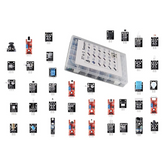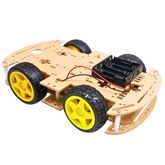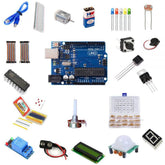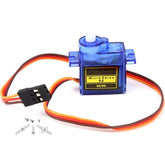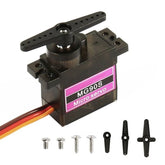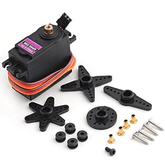Controllers, Sensors & Actuators in Robotics
Summary
Explore the dynamic world of robotics in our latest blog, "Controllers, Sensors & Actuators in Robotics." Delve into the intricate balance of these components, where controllers serve as the brains orchestrating logical functions, sensors gather vital input data, and actuators execute physical actions. Uncover the pivotal role of seamless integration between these elements and discover cutting-edge robotic control strategies. From robotic operating systems to the essence of synergy, this blog navigates the intricate web that powers modern robotics. Join us on a journey through innovation, efficiency, and the captivating realm of robotic intelligence. Don't miss out—click now for a glimpse into the future!
Introduction
Robotics is an expansive interdisciplinary field encompassing wide-ranging applications from manufacturing automation to robotic prostheses. Robotics incorporates principles of electrical engineering, mechanical engineering, material science, computer science, mechatronics, and more to impart advanced capabilities. Through the harmonious integration of control, sensing, and actuation systems, robots can perceive environments, interpret sensory data, deliberate over actions, and respond physically to achieve set goals with a high degree of autonomy.
At the core of any robotic system are three key components that work in unison to enable functioning: controllers, sensors, and actuators. The controller houses the logic, programming, and decision-making capabilities that guide a robot’s behaviors and actions. Sensors are the eyes and ears, detecting stimuli like light, sound, or pressure and converting those phenomena into electrical outputs usable by the controller. Actuators translate controller instructions into movement through motors, hydraulics, artificial muscles, or other means. This article will provide an in-depth examination of each of these integral pieces of robotics, how they operate independently, synergize within robotic systems, and collaborate to create fully capable machines.

Controllers: The Brains Coordinating Logical Functionality
The controller provides the intelligence and coordination that enables a robot to sense, plan, and act. This crucial component receives and interprets data from sensory inputs, decides on appropriate responses, implements algorithms, and signals output actuators accordingly. At the heart of the controller is one or more microprocessors along with the robot’s "programming"—whether hard-coded software, dynamically updated machine learning algorithms, deep neural networks, or other logic.
- In many ways, robotic controllers provide computational power comparable to a small computer. Their key responsibilities include:
- Accepting streams of digitized data from the sensor transducers and extracting meaningful information.
- Making higher-level decisions based on logic, stored instructions, machine learning algorithms, or deep learning neural networks.
- Issuing output actuator commands to prompt physical actions like movement sequences, data capture, object manipulation, sound generation, display updates, and more.
- Implementing safety checks, error detection, remote override protocols, troubleshooting routines, and other resilient programming.
There are several controller architectures spanning centralized to distributed setups:
- Microcontrollers are compact, self-contained units designed to handle basic sensorimotor tasks for small robots or single subsystems. They are low-cost, low-power, and have limited computational capacity.
- Centralized controllers use one main computer to process all sensor data and coordinate all actuators in a robot. This works well for non-complex robots and tight integration, but lacks distributed processing.
- Distributed controllers delegate control across multiple networked microcontrollers, each governing a subset of sensors and actuators. This provides greater expandability and compartmentalized functions.
- Hybrid controllers combine centralized and distributed approaches for more flexibility. Multi-level hierarchies can tie localized microcontrollers to higher centralized computers.

No matter the implementation, robotic controllers enable sensory perception, deliberation over environmental stimuli, planning, and final output control signals that bring responsive physical actions to life. Advanced controllers support dynamic re-tasking, environment mapping, simultaneous localization and mapping, obstacle avoidance, machine vision, object manipulation, and human-robot interaction.
Sensors: Gathering Critical Input Data
Sensors are transducers that detect real-world conditions like light, temperature, acceleration, or proximity and convert those phenomena into electrical outputs usable by robot controllers. They serve as the eyes and ears that allow robots to receive vital status information and environmental feedback. Different types of robotic sensors include:
- Proximity sensors utilizing ultrasonic sound, infrared light, or laser rangefinders to gauge surrounding distances and detect nearby objects without physical contact. This helps robots avoid collisions.
- Vision/camera sensors, including monocular, stereo, and 3D configurations, that employ advanced computer vision and image processing algorithms to visually perceive environments. High resolution cameras and LIDAR sensors provide rich environmental data.
- Force sensors, force-torque sensors, and strain gauges that measure contact pressure, grip strength, and other forces and torques during physical robot interactions. Useful for robotic assembly, handling delicate objects, and human safety.
- Inertial sensors like accelerometers, gyroscopes, and IMUs that track orientation, vibration, tilt, and other motion-based data to aid in stability, positioning, and dead reckoning navigation when GPS is unavailable.
- Temperature sensors monitoring operating conditions and helping regulate robot component heating and cooling. Critical for motors, batteries, bearings, and electronics.
- GPS sensors incorporating global position satellites to provide location awareness and support waypoint navigation. Useful for drones, self-driving vehicles, and field robots.
- Tactile sensors that respond to different types of touch, which is important for manipulating objects and for safe human-robot interaction.

Sensor data might indicate the robot's current coordinates, a nearby obstacle, an object held in a robotic claw, unstable floor vibrations, a hot motor, or any other relevant states requiring the controller's attention. This real-time sensory feedback loop enables reactive control and informed actuation. Advanced sensor fusion combines disparate sensing modalities into unified environmental models.
A complete guide to the Types of Sensors in IoT
Actuators: Executing Physical Actions
Actuators are electro-mechanical devices that manipulate or move parts of a robot according to controller instructions. They essentially turn controller decisions into observable, physical actions. Actuators serve as the muscles that enable locomotion, object handling, environmental interaction, and other robotic functions. Common robotic actuators include:
- Electric motors powering wheels/tracks for ground-based robot mobility, joint rotation for robotic arms, and rotors for aerial drone movement. High torque, high precision servo motors provide a wide range of motion control.
- Pneumatic actuators that use compressed air to extend, retract, grip, or press robotic components. Fast and powerful. Useful for industrial robots.
- Hydraulic actuators operating similarly to pneumatics but with pressurized fluid power. Enable high forces for heavy lifting.
- Piezo actuators that utilize crystal properties to create small precise physical displacements in response to electric signals.
- Shape memory alloy actuators made from materials like nickel-titanium that change shape when heated or cooled. This enables robotic motion.
- Artificial muscles made from polymer fibers and electroactive polymers that flex or contract when voltage is applied. Mimics natural muscle.

Other actuators control sound, lights, displays, vibration, and various indicators. Like human muscle tissue responding to nerve signals, actuators contract, extend, pivot, rotate, or perform other motions to enact changes in the robot and its surroundings. This bridges the gap between computational control and measurable real-world results.
Importance of Integration Between Components
While controllers, sensors, and actuators can function independently to some degree, they are far more capable when seamlessly integrated into a unified robotic system. Without actuators, controller-sensor systems could observe environments but not physically respond or accomplish tasks. Without sensors, controllers would be blind and actuators would flail about aimlessly. Robots require well-orchestrated interplay between these pieces to operate usefully.
The controller processes continuous high-speed sensory data, analyzes the robot’s internal state and surroundings, evaluates ongoing activities, and decides in real-time which immediate actions should occur. It then signals specific actuators like motors or pneumatics to execute the desired movements or manipulations. This forms an adaptive control loop allowing the robot to respond intelligently even as conditions rapidly change.
With tight harmony between components specialized in sensing, thinking, and acting, robots can tackle highly dynamic real-world environments. Seamless integration empowers robots to react in real time, adjust behaviors, explore environments, iteratively complete tasks, recover from mishaps, maximize efficiency, and improve through machine learning algorithms. Responsive sensory-controller-actuator loops are what enable advanced autonomous robot behavior.
Robotic Control Strategies
Several control strategies are used to coordinate the complex interactions between sensors, controllers, and actuators:
- Open loop control is the simplest approach and involves executing pre-programmed actuator commands in sequence without any sensory feedback. This is unreliable in dynamic environments.
- Closed loop feedback control uses continuous sensor data to dynamically adjust actuator outputs for more adaptive response. This is far more effective than open loop.
- Proportional-integral-derivative (PID) control uses feedback to minimize errors between desired and actual outputs by adjusting proportional, integral, and derivative parameters. PID is ubiquitous in robotics.
- Optimal and adaptive control methods use models and optimization to continually tune controller parameters and improve performance. Machine learning can update models.
- Hybrid control combines techniques like behavior-based subsumption architecture, expert systems, reinforcement learning, neural networks, and more for highly advanced control.
Cutting edge techniques even enable multiple coordinated robots to synchronize actions and share sensory data for collaborative goals. Multi-agent swarm robotics exhibits emergent intelligence.
Robotic Operating Systems
Controller software has also progressed from simple programmed commands to full-fledged robot operating systems (ROS). ROS provides hardware abstraction, device drivers, libraries, visualizers, message passing, package management, and other functionality. ROS enables complex behaviors and robust integrations. It runs on Linux systems and can coordinate advanced sensors, actuators, and algorithms. Modular program nodes can be individually updated.
Major ROS versions like Noetic Ninjemys have transformed robot application development. With sophisticated tools and capabilities built atop Linux, ROS empowers everything from autonomous drones to self-driving cars and robot swarms. It is open source with an ecosystem of community contributions. ROS furthers the abilities of robotic controllers and their integration with complementary components.
Conclusion
Controllers, sensors and actuators each serve distinct purposes in robotics, but it is their seamless integration that enables robust functionality. The controller processes streaming sensor data about the external environment and robot status to make informed decisions about optimal actions. It signals instructions to various actuators that in turn create desired physical movements and manipulations.
This adaptive closed-loop control cycle of sensing, processing, deciding and acting is what allows robots to complete useful tasks across manufacturing, logistics, surgery, space exploration, transportation, and more. Advancements in sensor technologies, controller logic, actuator designs, and system integration allow robots to take on increasingly complex real-world challenges. A symbiotic relationship between a robot’s “brain,” “senses” and “muscles” is what brings these machines to life and enables advanced autonomy.







